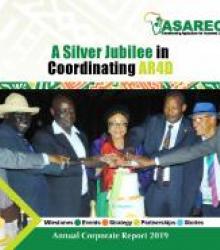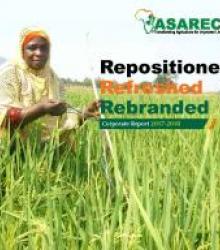| Title | Author | Asbract |
|---|---|---|
| Agricultural Innovation Systems and Value Chains Development: A Training Manual | Joseph Methu, Julius Nyangaga, Amos Waweru and Doris Akishule | his is one of a series of training modules developed following several workshops on agricultural innovation systems (AIS) and value chains development (VCD) organized for principle investigators of ASARECA programs in 2010 and 2011. The modules were compiled to assist in facilitating similar training that participant trainees may organize. The principle behind teaching and presenting the two concepts of innovation systems and VCD is based on the fact that they are strongly related, and there is opportunity for thinking and applying the two together in most agricultural programs. These modules are best presented in 2-hour sessions using a suggested 3, 4 or 5-day program. In the 4 or 5-day program, 1 day should be dedicated to a field activity, such as a visit to a value chain network or innovation system so that participants get hands-on experience of various aspects such as roles, contribution and benefits of the relationships in the innovation system, and participate in monitoring and evaluation. The 35-day training period is too short to cover essential details of understanding and operations of innovation and VCD. The most affected is VCD, which, on its own, should be taught in not less than 5 days. A well-developed VCD training program extends for at least 10 consecutive days (or stretches for a full 2 weeks). However, these sessions have been designed for program managers to expose them to basic information that can be used to design and manage programs. The training sessions therefore present introductory modules to various related concepts. It is expected that by the end of the 35-day course, trainees will have a basic understanding of the two concepts and how they can be presented in proposals, detailed strategies and action plans as well as what could go into performance tracking. In addition, at the end of each topic there is a Reference and Further Reading section that shows areas and topics that the trainees should make efforts to get for more information (knowledge). The full list of modules and suggested training program is shown in the following schedule. |
| Payment for environmental services: Laying the ground work | ASARECA | Between 2009-2011 ASARECA supported a consortium of five institutions in three countries, namely, the School of Environmental Studies (Moi University), Kenya Agricultural Research Institute (KARI), and VIRED International ÔÇô all of Kenya; University of Kinshasa & INERA of D. R. Congo; Nature Harness Initiatives and the Environmental Conservation Trust both of Uganda, to conduct research to develop methods for Valuation, Attribution and Compensation for Payments for Environmental Services (VAC-PES) in Eastern and Central Africa. The target research landscapes were the Mt. Elgon Region (Cross boundary between Uganda and Kenya) and the Albertine Rift (between Uganda and DRC). Many other institutions have carried out studies and undertaken PES related activities in other landscapes in Eastern and Central Africa, but the information on these activities occurs in a disjointed manner. The papers presented in this book are an attempt to pool some of this information into one volume. The papers cut across different aspects of Environmental Services (watershed management, carbon sequestration, and biodiversity management), as well as policy and institutional issues related to PES. It is envisaged that this publication will provide information necessary to spur PES programmess in the region. |
| ASARECA Operations Manual Vol.1 | ASARECA | Grants Solicitation, Financial Management and Internal Audit |
| Administrative Policies and Procedures, and Procurement and Disposal Guidelines | ASARECA | The Association for Strengthening Agricultural Research in Eastern and Central Africa (ASARECA) is a sub-regional not-for-profit Association. It was formally established in 1994 by ten member States represented by their National Agricultural Research Institutes (NARIs) following the approval of the Framework for Action (FFA) for Agricultural Research in Eastern and Central Africa by the Special Programme for Africa Agricultural Research (SPAAR). The original ten member States included Burundi, represented by Institut des Sciences Agronomiques du Burundi (ISABU); Democratic Republic of Congo, represented by Institut National pour l’etude et la’ Recherche Agronomique (INERA); Eritrea, represented by the National Agricultural Research Institute (NARI); Ethiopia, represented by Ethioipian Institute of Agricultural Resaerch (EIAR); Madagascar, represented by Centre national de recherché appliqué au Development Rural (CERADERU/FOFIFA); Rwanda, represented by Institut des Sciences Agronomiques du Rwanda (ISAR); Sudan, represented by Agricultural Research Corporation (ARC);Tanzania, represented by Department of Research and Development (DRD); and Uganda, represented by the National Agricultural Research Organization (NARO). Subsequently, South Sudan joined ASARECA during the General Assembly convened in December 2011, while the Republic of the Congo (RoC) joined the Association in 2019, bringing the total membership to 12. |
| Tanzania Fisheries Research Institute | ASARECA | The warning was sounded by TAFIRI researcher Mary Kishe in Dar es Salaam when speaking to The Guardian in an exclusive interview shortly after the just ended consultative workshop on Food Price Trend Analysis: Implication to Food Security in Tanzania, organized by Association of Strengthening Agriculture Research for Eastern and Central Africa (ASARECA). |
| Farmers speak of technology benefits | EAAPP - ASARECA | |
| Predictions warn of rapid MLN spread, spell doom in AFRICA | Brian Isabirye and Ivan Rwomushana | The Maize Lethal Necrosis (MLN) disease is so dangerous that we cannot wait for its next victims incognito. These are direct words of Dr. Brian Isabirye, the ASARECA official in charge of coordinating regional efforts to curb the spread of MLN in Eastern and Central Africa. MLN was first spotted in Kenya in 2011, before spreading to Uganda, Ethiopia, Tanzania and Rwanda. We are not very certain of where it will attack next, says Dr. Isabirye. As the saying goes, fore warned is fore armed predictive study to predetermine potential areas of risk of infestation by MLN was undertaken by ASARECA in partnership with colleagues in the region. The study attempts to understand the spatio-temporal distribution of MLN risk in Africa using ecological niche models, which include inputs such as climatic data (temperature and rainfall) and known detections of MLN across Africa. Outcomes of the modeling published in the Journal of Crop Protection indicates that a high risk of MLN across the warm arid, semi arid, and sub-humid tropics of Eastern and Southern Africa. Western and Southern Africa showed only moderate suitability, while much of North Africa appears to be marginal in risk. The countries with largest modeled suitable habitats for MCMV virus were Ethiopia, Tanzania, D.R. Congo, Angola, South Africa and Madagascar. In terms of proportional potential yield loss, Rwanda, Burundi, and Swaziland are likely to be worst hit with 100% yield loses, followed by Uganda (88.1%), Tanzania (65.9%), Ethiopia (59.8%), Malawi (53.8%), Madagascar (45.1%), and Kenya (41.1%). See full article pdf and link http://jcp.modares.ac.ir/article_14054_5288be780a04c484c434e32a2667e31b.pdf |
| Farmer awareness key as maize comes under attack | Frank Kagoda, Robert Gidoi and Brian Isabirye | It is now scientifically double-checked. In Uganda, the Maize Lethal Necrosis Virus (MLN) is prevalent in most farmers fields in the districts of Tororo, Mbale, Sironko and Busia. According to survey findings published in the African Journal of Agricultural Research, the disease can attack at any stage of crop growth, two weeks after planting leading to average yield losses of up to 50.5% or US$ 332 per hectare. First reported in Uganda in 2013, information about the prevalence, yield loss, mitigation measures and socio-economic effects of MLN is still scanty. Survey findings of a study conducted by NARO and ASARECA involving 300 respondents in seven districts of Eastern Uganda on the status of the disease, recommends intensification of MLN sensitization to inform farmers on management practices such as crop rotation, good sanitation practices, and use of chemical sprays to control MLN. The study, however, indicates that expediting the breeding process for the development of MLN resistant or tolerant varieties is the most viable option to bring a lasting solution to the disease. |
| Simple tools, huge impact: How the Virtual Irrigation Academy is changing livelihood in Malawi | Ben Moses Ilakut, Moses Odeke, Dr. Isaac Fandika, Geoffrey Mwepa and Jonathan Chikankheni | Simple tools, huge impact: How the Virtual Irrigation Academy is changing livelihood in Malawi |
| Irrigation revolution: Delivering high yields under harsh climatic conditions in Tanzania | ASARECA | Irrigation revolution: Delivering high yields under harsh climatic conditions in Tanzania |
| Second ASARECA-EAAPP Report | Antony M. Kilewe, Violet O. Kirigua and Daniel Kilambya | The East Africa Agricultural Productivity Programme (EAAPP) was conceived in a regional perspective in which Ethiopia, Kenya, Tanzania and Uganda will manage investment with regional objectives to foster agricultural development in the Eastern and Central Africa Sub-region. EAAPP seeks to invest in commodities that have been identified in ASARECAÔÇÖs Strategic Plan as being of sub-regional importance for mitigation of food insecurity. Both ASARECA and EAAPP seek to contribute to the AU/NEPADÔÇÖs CAADP Pillar IV agenda which focuses on revitalizing, expanding and reforming AfricaÔÇÖs agricultural research, technology dissemination and adoption efforts, guided by the Framework for AfricaÔÇÖs Agricultural Productivity (FAAP). |
| THIRD ASARECA EAAPP Report | Antony M. Kilewe and Violet O. Kirigua | The Third ASARECA-EAAPP planning meeting was held from 24 to 28 January, 2011 at the Imperial Resort Beach Hotel, Entebbe, Uganda and was attended by a total of 68 participants drawn from the four EAAPP countries, representative of the World Bank, Uganda regional office and ASARECA Secretariat. The meeting was designed to take the participants through a participatory step-by-step process of reviewing, discussing and consensus building towards the finalization of the mechanisms for information sharing, out-scaling, capacity building, policy harmonization, assessment of the progress made towards the completion of the planning process and make appropriate recommendations on the way forward. In order to ensure effective delivery of the expected outputs, the meeting adopted a hands-on approach with a logical combination of plenary presentations, discussion group sessions and plenary feedback and consensus building sessions. |
| Bee-keeping for restoration of degarded ecosystems and improving livelihoods in East Africa | James Ateker Okiria | Bee-keeping for restoration of degarded ecosystems and improving livelihoods in East Africa |
| Climate Change Report | van de Steeg JA, Herrero M, Kinyangi J, Thornton PK, Rao KPC, Stern R, Cooper P. | The influence of current and future climate-induced risk on the agricultural sector in East and Central Africa. |
| Farmer seed initiatives on african indigenous vegetables | Moses Onim and Phoebe Mwaniki | CATALOGUING AND EVALUATION OF AVAILABLE COMMUNITY/FARMERS-BASED SEED ENTERPRISES ON AFRICAN INDIGENOUS VEGETABLES FOUR COUNTRIES.The overall objective of this study was to identify available community/farmer-based seed enterprise initiatives that focus on African Indigenous Vegetables (AIVs), evaluate the models/approaches used and recommend those that are promising for further development into economical viable models for scaling up. The information from the study will be used to develop project concept notes on scaling up of the viable AIV seed enterprises that integrate participatory variety selection and marketing linkages for both seed and the vegetables. |
Search
Search entail eLibrary collection
Copyright © 2025. All rights reserved.
Designed By ASARECA


